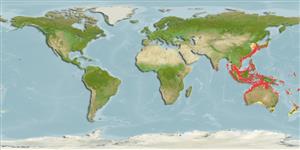Actinopterygii (ray-finned fishes) >
Perciformes (Perch-likes) >
Haemulidae (Grunts) > Haemulinae
Etymology: Pomadasys: Greek, poma, -atos = cover, operculum + Greek, dasys = with hair (Ref. 45335).
Environment / Climate / Range
Ecology
Marine; brackish; benthopelagic. Tropical, preferred ?
Western Pacific: China, Thailand, Singapore, Malaysia, and New South Wales, Australia.
Size / Weight / Age
Maturity: Lm ? range ? - ? cm
Max length : 52.0 cm TL male/unsexed; (Ref. 47695); common length : 43.0 cm TL male/unsexed; (Ref. 47695)
Dorsal
spines
(total): 12;
Dorsal
soft rays
(total): 14;
Anal
spines: 3;
Anal
soft rays: 7. Body color silvery to light burnished gold; dorsal fins with well defined blackish spots on interspinous membranes; adults with blackish spot on tip of each scale on back and upper sides. Body depth 3.2 tomes in SL. Head large; upper profile convex; gill cover and angle of preopercle lengthened as convex rounded lobe; gill cover extending to above 1/3 to 1/2 of pectoral fins. Mouth small; maxilla reaching to eye. Pores 2 and a median pit on chin (Ref. 47695).
A rare species apparently inhabiting deeper waters of the continental shelf (Ref. 47695).
Life cycle and mating behavior
Maturity | Reproduction | Spawning | Eggs | Fecundity | Larvae
Oviparous, distinct pairing during breeding (Ref. 205).
McKay, R.J., 2001. Haemulidae (=Pomadasyidae). Grunts (also sweetlips, hotlips, and velvetchins). p. 2961-2989. In K.E. Carpenter and V.H. Niem (eds.) FAO species identification guide for fishery purposes. The living marine resources of the Western Central Pacific. Volume 5. Bony fishes part 3 (Menidae to Pomacentridae). Rome, FAO. pp. 2791-3380. (Ref. 47695)
IUCN Red List Status (Ref. 115185)
CITES (Ref. 94142)
Not Evaluated
Threat to humans
Harmless
Human uses
More information
ReferencesAquacultureAquaculture profileStrainsGeneticsAllele frequenciesHeritabilityDiseasesProcessingMass conversion
Tools
Special reports
Download XML
Internet sources
